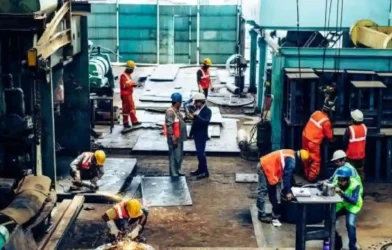Subtotal ₹0.00
The Reserve Bank of India’s decision to keep the repo rate unchanged at 5.5% in its MPC meet on Wednesday has drawn mixed but largely positive reactions from real estate leaders, who view the move as a signal of stability amid global uncertainties. While experts welcomed the steady borrowing costs that help sustain buyer sentiment and provide clarity for developers, many highlighted that further rate cuts would have amplified the impact of the recent GST rationalisation, especially for the affordable and mid-housing segments.
With GDP growth projections revised upward to 6.8% and construction costs expected to ease due to GST reductions, industry stakeholders believe the combination of policy stability, tax reforms, and festive season momentum could drive housing demand across segments — even as calls for additional monetary easing grow louder.
Here’s what India’s top real estate experts and developers said about the RBI decision to keep the repo rate unchanged:
Anuj Puri, Chairman, ANAROCK Group: “RBI’s decision to keep the repo rate unchanged at 5.5% maintains home loan EMIs at current levels, which helps sustain buyer sentiment but does not improve housing affordability. This stability means existing home loan borrowers won’t see any immediate EMI changes, while new borrowers will find loan interest rates holding steady. As per latest ANAROCK data, Q3 2025 residential sales in India’s top 7 cities dropped 9% year-on-year to 97,080 units, yet overall sales value jumped 14% to INR 1.52 lakh crore, indicating demand shifted towards premium and mid-segment homes.
However, the recent GST rate cuts provide significant relief. With GST on cement reduced from 28% to 18%, construction costs are expected to fall by 3-5%, potentially reducing home prices by 1-1.5% for buyers. This reduction could save homebuyers INR 1-3 lakh on purchases, particularly benefiting affordable and mid-segment housing where cost sensitivity is high. ANAROCK data shows that affordable housing’s share has declined from 38% in 2019 to just 18% in 2024, making these GST cuts crucial for reversing this trend. The combination of stable interest rates and lower construction costs creates a favorable environment for housing demand, especially during the ongoing festive season.”
Dr Samantak Das, Chief Economist and Head of Research and REIS, India, JLL: “The potent combination of a rate cut on top of the recent GST reforms would have provided a significant boost to the residential market, especially the affordable and mid segments, which, after a strong run, began to show early signs of growth moderation in the second quarter of 2025. For the residential market, this stability in capital cost provides a clear runway for developers. It nurtures the organic momentum we are seeing, ensuring growth is sustainable and not artificially inflated. This predictability is equally critical for the commercial real estate sector, which continues its record-breaking run. Stable capital costs are essential for the large-scale investment decisions that have propelled India’s office market to new heights. The RBI is signalling that the Indian economy’s fundamentals are strong enough to weather external storms, a message that will resonate strongly with global investors.”
Shekhar Patel, President, CREDAI: “The RBI’s decision to hold the repo rate at 5.5% gives the housing sector the steadiness it needs amid global uncertainty. Predictable borrowing costs allow buyers to plan long-term and give developers the clarity to progress financing and projects. Recent GST rationalisation has lifted sentiment and increased demand across sectors, reinforcing the positive backdrop. With gold and equity markets volatile, residential property continues to be a dependable store of value. While markets had anticipated a 25-basis-point cut today, we remain hopeful the RBI will deliver a cumulative 50-basis-point easing this fiscal in two tranches, which would further support activity. It is essential that banks pass these benefits to both new and existing borrowers so policy continuity and tax reform translate into sustained demand through the festive season.”
G. Hari Babu, National President, NAREDCO: “The decision to keep the repo rate at 5.5% alongside the projected real GDP growth of 6.8% is welcome. However, just as the government has boosted various sectors by cutting GST, a reduction in the repo rate is needed to energise the real estate sector. We urge the RBI to consider bringing the repo rate below 5.5% in the next MPC meeting. Lower interest rates will strengthen homebuyers’ confidence, increase housing demand, and particularly benefit the affordable housing segment. Supporting industries linked to real estate such as cement, steel, electricals, piping, and interiors will also see growth. A cut in repo rate will reduce EMIs on housing loans, enhance the purchasing capacity of middle-class families, and give further momentum to government missions like ‘Housing for All.’”
Pradeep Aggarwal, Founder & Chairman, Signature Global (India) Ltd: “The move is expected to sustain positive momentum across sectors, including real estate, by supporting liquidity, boosting consumer confidence, and encouraging investment activity. With the festive quarter beginning on a strong note and GST reforms further lifting sentiment, the housing sector is likely to continue witnessing steady demand across segments. Traditionally marked by heightened consumer activity, this period creates a favourable environment for property purchases and further strengthens market optimism. Looking ahead, the status quo is set to ensure a stable and balanced growth trajectory for the real estate ecosystem, benefiting developers, buyers, and allied sectors alike.”
Akhil Saraf, Founder & CEO, Reloy: “The RBI decision to maintain the repo rate at 5.50% and to keep a neutral policy stance is a balanced move given the current environment. The implications for the real estate sector are mixed but predominantly positive. The stability in home loan interest rates provides buyers with clarity and supports demand, particularly in the mid-income and affordable housing segments. As India’s economic momentum begins to show signs of moderation, the real estate industry finds itself in a unique position to serve as a catalyst for growth, potentially attracting investments and enhancing housing demand across various segments. However, the absence of additional monetary easing suggests that a rapid recovery cannot be expected solely from such measures; instead, a sustained recovery will likely hinge on robust fiscal incentives, meaningful regulatory reforms, and heightened consumer confidence.”
Raoul Kapoor, Co-CEO, Andromeda Sales and Distribution: “The RBI’s decision to maintain status quo on policy rates comes in line with market expectations. As the RBI Governor highlighted, prevailing uncertainties around global trade tariffs and geo-political issues leave little room for further rate cuts at this stage. At the same time, the Governor emphasized that the recent policy support through GST rationalization is expected to strengthen domestic growth momentum. Importantly, the cumulative 100 basis point rate cut delivered so far this year has already enhanced borrowing affordability in a meaningful way. To put this into perspective, a 100 bps cut reduces the EMI on a ₹1 lakh loan with a 20-year tenure by approximately ₹65 per lakh—translating into savings of nearly ₹1625 and ₹3250 respectively for loans of ₹25 lakh and ₹50 lakh.
When combined with additional savings from the revised income tax slabs and lower GST on key goods and services, household purchasing power has improved considerably. This creates a strong environment for credit demand to rise. As we move into the festive season, we expect to see a significant boost in borrowing across categories—ranging from consumer loans to housing finance—driven by improved affordability, policy support, and stronger consumer sentiment.”
Amit Goyal, Managing Director India, Sotheby’s International Realty: “The RBI decision to hold the repo rate at 5.50% offers stability at a time when both homebuyers and investors are seeking clarity. For end-users, steady borrowing costs help sustain affordability and confidence, particularly as demand for larger, lifestyle-driven homes continues to grow. For investors, predictability in monetary policy reinforces India’s appeal as a resilient, high-growth real estate market, especially in the luxury segment where global capital is showing rising interest. This pause is about signaling long-term confidence — an opportunity for the industry to consolidate demand, innovate, and deliver with greater consistency.”
Pyush Lohia, Director of Lohia Worldspace: “RBI holding the repo rate at 5.5% reinforces market stability and signals a measured approach to balancing growth and inflation. This clarity benefits both developers and homebuyers, providing a predictable environment for decision-making. The upward revision of GDP growth to 6.8% is particularly positive for Tier-2 markets, where rising aspirations meet the need for affordable, quality housing. Stable borrowing costs in these cities create opportunities for first-time buyers while giving developers the confidence to plan and execute long-term, sustainable projects rather than short-term cycles”
Vikas Bhasin, Managing Director, Saya Group: “The RBI’s decision to maintain status quo on policy rates is a welcome and expected move. This year, we have already witnessed significant support from the government—starting with consecutive policy rate cuts, followed by tax-saving measures in Budget 2025, and most recently, the rationalization of GST. Collectively, these initiatives have strengthened household savings and boosted the confidence of homebuyers. With these policy-driven benefits in the backdrop, coupled with attractive festive offers from developers and lenders, we anticipate strong demand from homebuyers this festive season as they look to make the most of this favorable environment.”
Nitin Bavisi, CFO, Ajmera Realty & Infra India Ltd: “The RBI’s decision to keep the repo rate unchanged at 5.5% for the second consecutive meeting, after a cumulative 100 basis point cut earlier this year, showcases a thoughtful balance between sustaining economic growth and ensures financial stability. The easing of inflation along with CRR and revised positive GDP growth projections for FY26 raised to 6.8% (vs. 6.5% earlier ) together augurs well for the Indian real estate sector, keeping the consumer sentiment and industry momentum upbeat right at the cusp of festive season. For the housing sector, especially during the festive period when demand normally surges, the consistency in monetary policy sends a strong positive message. It boosts customers confidence and empowers them to make decisions right in time. Furthermore, supportive policy interventions like GST rationalization, coupled with lower inflation trends and India’s sound economic fundamentals, again bolster the growth profile of the sector.”
Sudipta Roy, Managing Director & CEO, L&T Finance Ltd: “MPC announcements this morning were the right balance of prudence in monetary policy actions while easing credit conditions in the real economy. The status quo in policy rates was along the expected lines. However, the real action was contained in the various measures announced to improve the flow of credit in the economy. Measures like the glide path towards ECL framework, expanding scope of capital market lending, removing restrictions on collection accounts etc. are all aptly timed and will help the financial system to aid aspirational growth levels. RBI upgrading growth expectations for the current fiscal year is also a big reassurance of strong domestic momentum despite external headwinds. The Governor’s message of alignment in all domestic policies- fiscal, monetary, and regulatory, towards Viksit Bharat goals has taken the focus away from short-term external challenges towards domestic resilience and medium-term economic potential.”
Ashish Sharma, AVP Operations, Brahma Group: “We welcome the RBI decision to keep the repo rate steady at 5.5% with a neutral stance, as it provides the much-needed stability for the real estate sector. Consistent borrowing costs help keep EMIs affordable for homebuyers while enabling developers to allocate capital efficiently across ongoing and large-scale projects. This monetary consistency will reinforce buyer confidence, drive activity in price-sensitive markets, and ensure healthy liquidity. We expect sustained demand across residential and commercial segments, supporting long-term sectoral growth and strengthening overall market stability.”
Santosh Agarwal, Executive Director & CFO, Alpha Corp Development Limited: “The RBI decision to maintain the repo rate at 5.5% for the second consecutive time reflects a balanced approach to sustain economic stability while to keep inflation in check. For the real estate sector, stability in lending rates ensures predictability for both developers and homebuyers. Developers can continue managing capital efficiently without sudden disruptions in financing costs, while homebuyers benefit from steady EMIs, supporting confidence in long-term investments. This consistency is particularly important for ongoing and large-scale projects, as it sustains demand across residential and commercial segments, improves cash flow stability, and strengthens overall market sentiment.”
Abhishek Trehan, Executive Director, Trehan Iris: “This move reinforces economic stability, boosts investor confidence, and provides much-needed predictability for both homebuyers and developers. Stable lending rates ensure affordability for buyers through consistent EMIs, while enabling developers to manage capital and financing for ongoing and large-scale projects more efficiently. We remain optimistic that the real estate sector will witness sustained demand, accelerated growth, and long-term value creation across residential and commercial markets.”
Rajan Luthra, CFO, Action Construction Equipment (ACE) Ltd: “The RBI’s decision to maintain the repo rate provides a stable and predictable environment for capital-intensive sectors like construction equipment. Stability in financing costs is essential for contractors and infrastructure developers to plan and execute projects efficiently, ensuring momentum in the sector is maintained. Coupled with recent GST reforms, which ease input costs and improve project economics, the overall environment is supportive of sustained investment and long-term growth.”
Parvinder Singh, CEO, Trident Realty: “The decision to keep the repo rate steady at 5.5% comes at the right time for the second time consecutively, with inflation easing and growth prospects looking stronger for FY26. A stable interest rate environment gives homebuyers the confidence to take firm decisions, especially when many are looking to upgrade to bigger homes during the festive season. For developers, it creates the right backdrop to push deliveries and launches without the overhang of rate volatility. This stability gives both buyers and developers the confidence to move ahead without added financial pressure.”
Ashish Agarwal, Director, AU Real Estate: “The decision to keep the repo rate unchanged at 5.5% comes at a critical juncture for the housing market. Homebuyers are already recalibrating budgets to move into more spacious living, and keeping rates steady ensures affordability doesn’t slip out of reach. Even a 25-basis-point hike could have meant thousands more in EMI outgo, which often makes buyers defer decisions. For developers too, with project finance costs elevated and delivery timelines tightening, rate stability allows focus on execution rather than firefighting financial volatility. This will help the festive buying momentum convert into concrete sales, rather than remaining at the level of enquiries or intent.”
Aman Sharma, Founder and Managing Director, Aarize Group: “While the RBI has wisely held the repo rate steady at 5.5 percent after cumulative cuts of 100 bps this year, the real estate sector now awaits quicker transmission of these cuts to lending rates. A modest rate reduction or a dovish stance would significantly improve affordability for homebuyers, revive sales momentum, and encourage fresh investments in housing. For developers, such a move would not only boost demand but also reinforce confidence in stability and policy support.”
Mohit Goel, Managing Director, Omaxe Ltd: “The RBI’s decision to maintain policy stability at the onset of the festive season is a timely and growth-supportive move. This period has always been a catalyst for homebuying decisions, and steady interest rates will further strengthen consumer confidence and purchasing power. The recent GST rate cuts add another layer of optimism by improving overall affordability and stimulating spending sentiment. Together, these policy measures create a conducive environment for housing demand, particularly in tier-II and tier-III cities where value sensitivity drives decisions. We expect the festive quarter to witness strong traction across residential segments as buyers look to capitalise on favourable market conditions and long-term growth prospects.”
Amrita Gupta, Director, Manglam Group: “As the economy continues to show resilience and positive momentum, this festive season brings with it renewed optimism for homebuyers. Coupled with recent GST benefits, this stable policy backdrop is inspiring demand across tier 2 and 3 markets, particularly in Jaipur, where buyers are seeking affordability, aspirational living, and long-term value creation. At Mangalam, we believe this confluence of festive sentiment, supportive policy measures, and the rising growth of emerging cities will accelerate sustainable urbanisation and further strengthen India’s real estate growth story.”
Aditya Kushwaha, CEO and Director, Axis Ecorp: “This year has seen strong momentum in the real estate market, with buyers increasingly confident about investing, and the current economic environment continues to support informed investment decisions. The RBI’s decision to hold rates reflects a cautious but steady approach, which is reassuring for buyers in the middle of the festive season. Stability in monetary policy keeps sentiment positive for holiday homes, where both NRIs and domestic buyers are showing strong interest. Along with the recent GST concessions on construction inputs, it creates an environment where second homes remain attractive as both lifestyle and long-term investment assets. We see this as a window where second homes, especially in markets like Goa, will attract more decisive investments.”
Rohit Kishore, CEO, Hero Realty: “Stable borrowing costs will benefit both homebuyers and developers. For buyers, it means continued lower EMIs and easier access to home loans, which can encourage more people to buy homes. For developers, the sustained interest rates will help manage costs and finish projects on time. This policy continuity will boost confidence in the market and maintain demand for homes and office spaces. We expect the luxury housing segment to stay strong, especially in metro cities. Lower EMIs and better loan offers will make people more confident to buy. For the real estate industry, especially the residential sector, the RBI’s decision underlines stability and predictability, two factors widely regarded as essential for sustained market health.”
Sudeep Bhatt, Director Strategy, Whiteland Corporation: “The RBI decision to maintain the repo rate at 5.50% is a strong positive for the Delhi NCR housing market. We’ve seen steady growth following previous rate cuts this year. For homebuyers, it ensures a stable interest rate environment, boosting confidence. For developers, the pause allows focused project planning and execution without concerns over rising borrowing costs, supporting a robust pipeline for new launches. This will help sustain demand momentum. It’s a clear signal of continued housing sector growth and we expect sentiment across the region to remain optimistic.”
Mohit Agarwal, Business Head, Conscient Infrastructure Pvt. Ltd: “Continued lower borrowing costs will help preserve affordability for luxury homebuyers and investors, thereby sustaining demand in high-end residential markets. This unchanged stance, coupled with the MPC’s neutral outlook, reinforces confidence among HNIs and NRIs to make strategic real estate investments. As a developer, we continue to benefit from predictable financing costs, enabling steady project execution. We anticipate sustained momentum in the luxury housing sector, especially in metro cities, as stable EMIs and attractive financing options continue to drive buyer confidence.”
Raghav Malhotra, Director & Founder PRIME Developments: “Coupled with the recent GST rate cuts on various services and commodities, overall household expenditure is expected to ease, allowing buyers to allocate more towards long-term investments like housing. For developers too, stable borrowing costs and improved buyer sentiment provide a conducive environment to launch and deliver projects on time. Together, these measures support sustainable growth in the real estate sector and further encourage fence-sitters to move towards home ownership.”
The RBI’s decision to keep the repo rate unchanged at 5.5% is good news for anyone looking to buy a home. It keeps loan rates steady, making housing finance more affordable and giving buyers greater confidence to take that step.














